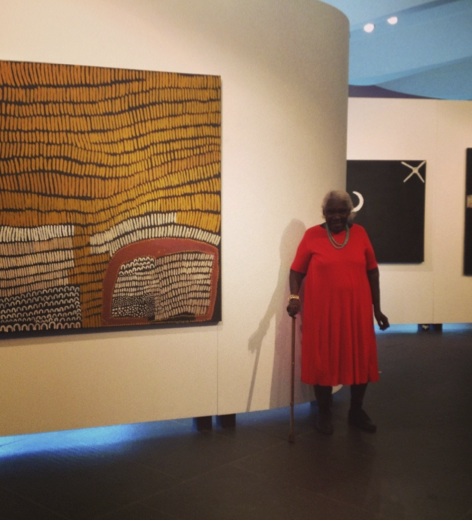“L’âme de votre peuple navigue depuis l’immensité du Kimberley jusqu’à la densité de Paris,”[1] a très justement déclaré Son Excellence M. Stéphane Romatet, Ambassadeur de France en Australie, le 6 juin 2013 à Paris lors de la cérémonie d’inauguration de l’installation monumentale Dayiwul Lirlmim de l’artiste Gija Lena Nyadbi.
La reproduction d’un détail de la toile somptueusement exécutée en noir et blanc par Lena, 46 fois plus grande que sa version originale, a été réalisée au moyen de pochoirs. Elle constitue l’ « ultime ponctuation » imprimée sur le bâtiment du musée, selon l’expression du Président du musée du quai Branly, Stéphane Martin. En effet, la commande publique que l’institution avait lancée en 2006 intégrait, de manière permanente, l’Art aborigène dans sa structure architecturale. De cette façon, le musée lançait une invitation aux publics occidentaux et non-initiés : une invitation à découvrir cette tradition de représentation née il y a des millénaires de l’autre côté du globe. Il rendait ainsi possibles la rencontre esthétique à travers la contemplation des œuvres et la participation active des visiteurs dans l’apprentissage, la compréhension et la connaissance du Rêve. Engagée dans cette ouverture réciproque des cultures et œuvrant pour la circulation de leurs signes, Lena Nyadbi contribua alors à l’expansion de l’art Aborigène en tatouant la façade de la rue de l’Université de motifs de Jimbirla (pointes de lance) et Gemerre (scarifications) – motifs attachés à l’héritage traditionnel du pays de son père, dont le relief est marqué par la présence de pierres coupantes utilisées comme têtes de lance.
Cette fois, sept ans après sa première contribution artistique, Lena a peint une autre histoire légendaire du pays Gija pour orner le toit de la médiathèque du musée du quai Branly : celle des Ecailles du Barramundi, qui façonnèrent sa terre d’origine au Temps du Rêve. Selon la légende, trois femmes pêchaient du barramundi au moyen d’un filet de spinifex, lorsque l’un des poissons se dégagea du filet en sautant et parvint à s’échapper par une faille rocheuse. Dans sa fuite, il perdit des écailles qui s’éparpillèrent et, avec le temps, devinrent de scintillants diamants. Significativement, l’histoire du Dayiwul Lirlmim est intrinsèquement liée à la région aujourd’hui connue sous le nom de Lissadell Station, qui abrite la mine de diamants la plus vaste au monde.
Le dévoilement de l’œuvre de Lena Nyadbi sur la « cinquième façade » du musée du quai Branly vient nourrir la dynamique originale selon laquelle Jean Nouvel, architecte du musée, avait délibérément conçu le bâtiment. Car le musée du quai Branly n’était pas destiné à se limiter exclusivement à abriter des œuvres et objets d’art. Il fut pensé pour mener une vie propre, pour devenir un signifiant et être lui-même porteur de sens, grâce aux œuvres d’artistes aborigènes qui recouvrent et ornent ses murs. L’accueil enthousiaste du public français qui a assisté à la cérémonie inaugurale, a regardé le film Rooftop (qui retrace l’histoire de la création de l’installation de Lena Nyadbi) avec émotion et plaisir, et chaleureusement acclamé l’artiste dans une salle comble, témoigne du succès rencontré par le projet. Dayiwul Lirlmim « affirme simultanément un élément culturel spécifique […], et sa beauté universelle »[2], a justement résumé Lee-Ann Buckskin, Présidente de l’Aboriginal and Torres Strait Islander Arts Board. L’attirance grandissante que le monde occidental manifeste pour l’Art aborigène révèle les forts échos que trouvent les représentations du Rêve dans ses réalités contemporaines, ainsi que l’importance de placer ces représentations au centre du dialogue interculturel.
En racontant l’histoire légendaire des Ecailles du Barramundi aux millions de visiteurs qui entreprennent l’ascension de la Tour Eiffel chaque jour, Lena permet à l’Ancêtre mythique de voyager jusqu’à Paris – peut-être même en remontant la Seine, qui coule au pied du musée, à la nage – et de poursuivre son périple avec les touristes internationaux de l’emblématique monument parisien, qui le ramènent jusque dans leurs pays d’origine.
« Eh bien, le Barramundi est partout »[3], conclut l’artiste dans le film Rooftop. Le Barramundi habite effectivement la capitale française de sa présence : au musée du quai Branly, mais également à l’Ambassade d’Australie à Paris. L’exposition Gija Manambarram Jimerrawoon (Les Anciens de la Loi depuis Toujours)[4], actuellement accueillie par l’Ambassade en réponse à l’inauguration de l’installation de Lena, présente les œuvres de huit éminents artistes Gija du Warmun Art Centre. Remarquablement, la scénographie de l’exposition n’est pas sans évoquer les écailles du Barramundi : l’agencement, structuré par des panneaux d’accrochage aux lignes courbes sur lesquels sont présentées les toiles, rappelle la forme des écailles que le Barramundi perdit dans sa fuite mythique. Aussi pouvons-nous filer la métaphore de S. E. Stéphane Romatet, et espérer que l’œuvre de Lena continuera de naviguer, à Paris et autour du monde.
